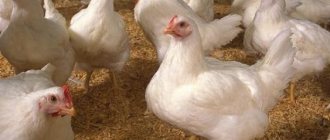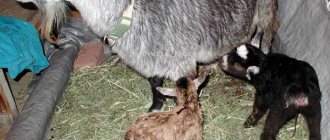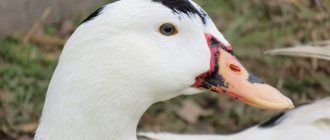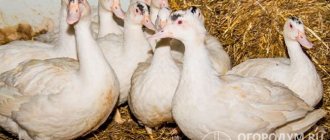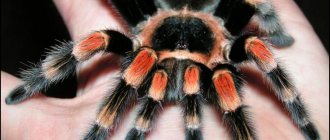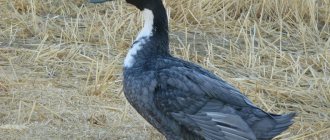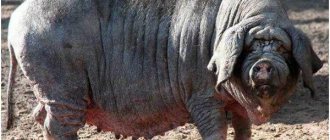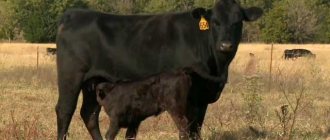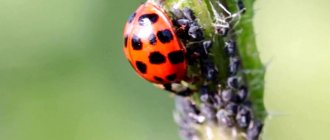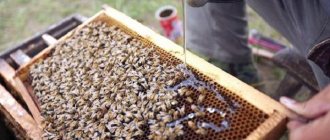Mulards are an unusual breed of duck that is not capable of producing offspring. It is grown to produce high-quality and tasty meat and tender liver. This breed was developed by crossing a Muscat duck with a domestic white Peking duck. Although females are infertile, they carry eggs. Raising ducklings is not a difficult task, since young animals have excellent immunity to many diseases. To breed Mulards yourself, you need to know all the nuances, familiarize yourself with the characteristics of the breed and the rules of keeping.
Description of the breed
Mulard is a hybrid with dark or light plumage and with the obligatory black spot on the head. With proper care, the weight of an adult duck is 3-4 kg.
The main profit from breeding mulards is obtaining a large amount of meat. Breeding is not expensive and simple. Under good conditions and proper feeding, you can get fatty and tender liver, which is used to prepare the popular dish “foie gras”. In order for the liver to be large and fatty, the bird is limited in movement and fed tightly.
Liver tastes very different from goose. It gained great popularity and became known as a delicacy. Duck meat is as fatty as goose, but has a delicate taste and no smell.
Advantages and disadvantages
Mulard ducks have a number of advantages:
- rapid weight gain;
- tasty, high-quality, odorless meat;
- small difference between female and male;
- immunity to many diseases;
- good cold resistance.
The only drawback is infertility.
What not to give to mulards
If you are unpretentious in food, Mulard ducks should not eat the following foods:
- Poisonous plants, such as celandine or henbane. When free-ranging, you need to monitor what grows in the area.
- Maple leaves are toxic to ducks.
- Fresh rye. Only mature grain can be fed.
- Raw nettle (adult plants) can burn the esophagus of mulards, so the grass is first scalded with boiling water and crushed.
- Fresh whole milk quickly turns sour and can lead to poisoning in ducklings and adult ducks.
- Flour and grain are ground into dust. Such products turn into dough that clogs the mullards' nostrils and beak.
- Stale food that is moldy, sour or fermented.
- Human food with salt, sugar, seasonings and spices.
Beginning poultry farmers are often interested in whether it is possible to give green onions to mulard ducks. It is necessary, it is useful for chicks and adult birds. The onion is chopped and given as part of the mash, and small ducklings are added to the chopped egg. This strengthens the immune system and prevents the development of a number of diseases.
Breeding at home
To increase the herd, you need to purchase a female Indian duck and a male Peking breed. Or a male Muscovy duck and a female of any domestic duck.
To achieve the long-awaited result, you must follow simple rules:
- You need to mate birds that are at least 6 months old and no more than 11 months old.
- Representatives of the same breed are kept separately. Since being together, the drakes will mate only with their females. As a result of crossing, there will be no crossbreeding, but simple reproduction.
- Create favorable conditions for ducks. The storage room is made warm, light and spacious. The food is of high quality, the water is clean.
- Crossing is carried out from late April to mid-June.
When crossing at home, you can observe that the male is not interested in the female. But don’t be upset, you need to give the drake time to adapt to the new place and then he will cover the female. If the male is a Muscat breed, the back of the Peking duck is painted with dark paint to quickly crossbreed. One male is capable of fertilizing 3-4 ducks.
Before the duck begins to lay eggs, you need to properly arrange the house.
A word about compound feed
Balanced complete feed is a good thing. However, modern production involves the introduction into its composition of a huge amount of synthetic amino acids, preservatives, taste stabilizers and feed antibiotics.
The use of compound feed in home fattening is possible, and poultry farmers very often trust this type of feeding. However, it should be taken into account that the quality of meat and liver, for which mulards are raised, is several times lower than when feeding is carried out with good-quality homemade food.
We recommend: A detailed description of the process of incubating turkey eggs.
Tips for arranging a poultry house
In order for the bird to feel comfortable, you need to properly arrange the goose coop, protect it from other birds and equip it with a nest.
Recommendations for beginners:
- The size of the poultry house depends on the livestock: per 1 sq. There should not be more than 4 individuals per meter.
- In order for the bird to feel comfortable in the winter, the coop must have electric or wood heating.
- A bedding of sawdust, straw or peat is laid on the floor. The litter is changed as it gets dirty, as parasites can appear there, which can lead to serious diseases.
- There should be no drafts in the room.
- Windows should open well so as not to disturb the bird.
- Nests are placed on the side opposite to the feeders.
- If there are 10 ducks in the goose coop, then no more than 5 nests are built.
- Wooden boxes or wicker baskets are used as nests.
- Size: width – 70 cm, height – 25 cm. For convenient entry and exit, a threshold is made no more than 10 cm high.
- Dry sawdust or straw is used as bedding. To keep the eggs clean, the litter should be changed as often as possible.
- On the opposite side, install a feeder, a drinking bowl and a bathing container.
- For egg planting to be successful, no more than 15 eggs are left in the nest.
To recognize fertilized eggs, you can use the drug ovoscope. If, upon examination, the vascular network is visible, then the egg is fertilized and can be placed on the duck. If the red ring predominates in the egg, then such an egg is removed. Mulard ducklings are born after 30 days.
For beginning farmers, breeding Mularda ducks should begin with the acquisition of chicks. When buying ducklings, you need to find out about the availability of vaccinations and observe the activity of the chicks. Litter also plays an important role. If it is liquid and abundant, then this indicates not only a gastric disorder, but also an infection.
If young animals are purchased in early spring, you need to take care of heating and lighting. But many, in order not to spend money on equipment, buy poultry in the summer based on slaughter at two months of age.
Content Features
There is nothing complicated about keeping and caring for Mulard ducks. They are resilient and unpretentious enough that a novice breeder can handle them.
Birds need to be provided with constant access to clean drinking water, but not in excess.
However, these birds have a number of features, knowledge of which makes work easier and increases its effectiveness:
- The intestines of “mulards” are shorter than those of other ducks. When there is an excess of water, they do not digest food completely, which reduces the rate of muscle gain and increases the cost of the final product. Experienced poultry farmers advise keeping grown hybrids without access to bathing areas, but equipping the house with drinkers deep enough for the birds to rinse their beaks. In addition, ducks should have constant access to containers with crushed shell rock or limestone, which are necessary for normal digestion.
- Young ducklings often peck at the litter. The floor in their room should not be covered with sawdust (kids can eat it and get sick). It is better to use clean straw or hay.
- “Mulards” often show a tendency towards cannibalism (they pluck each other’s feathers and can damage the skin until it bleeds). To reduce the likelihood of pecking, calcium and sulfur compounds, or special preparations (for example, Perovit), as well as ready-made vitamin and mineral complexes, are added to their diet from a week of age.
- If the bird is raised for meat, each individual must have at least a quarter of a square meter of living space and at least 1 square meter of walking area. “Mulards” are not known for their nervousness and timidity, but due to their gluttony and heavy weight, it is preferable to keep them separately from the rest of the feathered inhabitants of the farmstead. Hybrids practically do not fly, so the fence of the walking yard can be made low.
Despite the fact that purchasing young Mulard ducks is quite expensive, raising them is simple and economically profitable. Chicks quickly gain weight; when slaughtered at the age of 3 months, they can produce large carcasses, up to a quarter of the weight of which is fillet. Hybrids of this type are quite worthy of the attention of summer residents and rural residents.
The carcasses are large, but low in fat, providing a large yield of meat with excellent taste
Raising ducklings at home
Ducklings are born strong and with good immunity. But to get a healthy bird you need regular proper nutrition, good lighting and temperature control.
In the first days, the light is left on for the whole day. After 7 days, the time is gradually reduced, and by 11 days, 16-hour lighting is enough for the ducklings.
The room temperature should be from 20 to 30 degrees. If weather conditions permit, young animals can be taken for a walk. During the walk, the poultry house is ventilated and the litter is changed. You should refrain from sawdust, as the chicks can peck at it and die.
Feeding
Hatched ducklings do not know how to eat, so to prevent widespread pestilence, they are taught this. On the first day of life, each chick is given a pale pink solution of potassium permanganate through a pipette. Then the hard-boiled egg is mashed and the porridge is added. The food is laid out on dark cardboard and placed next to the chicks.
You can also crumble food onto the chicks themselves, so they will learn to grab moving food, which will make it easier to find food in the pond in the future. A day after the training, the chicks will be able to feed on their own.
Important 7 days
Ducklings are given a boiled egg only during the first week of life. It is mixed with porridge or finely crushed grain. The food should be moist and crumbly so that the young animals do not clog their beaks. On the third day after birth, greens are added to the diet, and at the end of the week - boiled potatoes.
At any stage of feeding, new foods are introduced in portions and small doses.
One of the aspects of care is the availability of clean water. The drinking bowl should be clean and deep so that the chicks can easily clean their nasal passages. From the 3rd day of life, in the presence of warm weather, ducklings are accustomed to walking and swimming in a shallow basin.
From the tenth day
From ten days of age, boiled potatoes and grain waste are added to the diet. From the 14th day - small algae, they strengthen the immune system, improve growth and development.
Meat and bone and fish meal, grain bran, boiled carrots and grated beets are also added. Beets are introduced in small portions, and if the chicks’ bellies sag, then it is better to discard this root vegetable.
At this age, ground eggshells, chalk, limestone or shells are useful. For better digestion, young animals should always have gravel.
All mineral supplements are kept in a separate feeder.
If there is a pond near the site, then you need to let the ducklings go swimming, so they will learn to catch duckweed on their own.
Until the age of one month, ducklings can be given milk or low-fat cottage cheese. Baker's yeast is considered a useful additive, calculated per gram per head. At 30 days of age, chicks can eat the same as other domestic ducks.
From one month
Since rearing mulards lasts 2-3 months, from the first month of life they are fed like adult birds. From this age you can add fresh zucchini and overripe cucumbers. The diet can be expanded with milk, bran and boiled meat waste.
In hot weather, ducks are fed 4 times a day. Twice dry and twice wet food. In addition, the diet should include fresh grass.
Read an interesting article - Little Dove: how to go out in an apartment.
In winter, they eat two meals a day: dry food and wet food with the addition of vegetables. The more varied the food, the healthier the bird will be, since in winter it lacks vitamins.
Laying hens are fed in a special way at any time of the year. The diet should be nutritious and balanced.
Amount of feed per day per individual:
| Type of feed | Quantity |
| Coarse salt | 1.4 g |
| Grain mixture | 60 g |
| Bone meal | 1.5 g |
| Boiled potatoes | 45 g |
| Greenery | 100 g |
| Vegetable waste | 5 g |
| Corn or barley flour | 110 g |
| Cake | 10 g |
| Chalk | 6 g |
When can you cut?
Up to 3 months All nutrition goes towards building muscle mass, so the fat ratio will be minimal. At the age of 70 days, mulards molt, so slaughter should be carried out at 2 or 3 months.
Features of the face
Before slaughter, poultry should be prepared in advance. This will help simplify subsequent processing of the carcass.
Main stages of preparation:
- put the mulards on a starvation diet 10-12 hours before the procedure;
- place the birds in a separate room and leave the lighting on, which will help to empty the intestines.
In the morning you can start slaughtering.
Sequence of actions when performing the procedure:
- Tie the paws and hang them upside down.
- Press the wings to the back.
- Pull back the neck and cut the carotid artery, while holding the knife at an angle to the neck.
- Leave the carcass hanging for 15 minutes.
- After the time has passed, remove, cut and remove the giblets.
Diseases and treatments
Although mularda is immune to many diseases, if hygiene rules are not followed, the following diseases can occur:
| Disease | Causes | Symptoms | Treatment |
| Aspergillosis | Improper care, infrequent replacement of bedding | The bird becomes lethargic, vomiting, difficulty breathing and lack of appetite | Add a 0.15% solution of copper sulfate to water, and the medicine Nystatin to food. You should ask your veterinarian for the dosage. |
| Baldness | Appears as a result of a lack of vitamins and protein, the disease can also be caused by dirt, excessive crowding, poor ventilation | The bird becomes lethargic and begins to pull out its plumage | Vitamins A and D are added to the diet, keeping the house clean |
| Cloacite | Lack of vitamins in food | Inflammation of the mucous membrane of the cloaca | Vitamins are added to the diet, and the cloaca is lubricated with iodine and zinc ointment. Advanced condition is treated with antibiotics |
| Polymorphosis | The disease appears due to worms that ducks become infected with through a body of water. | Poor appetite, vomiting, lethargy, diarrhea and weight loss | Add 0.1% copper sulfate to the water. The veterinarian also prescribes Filixan, Dichlorofen, Bitinol. The poultry house is completely disinfected. If treatment is not carried out, the bird dies at any age |
Disease Prevention
To keep the bird healthy and gain weight quickly, food is enriched with vitamins and microelements. They can be purchased at a specialty store and added to cooked food. If ducks are fed commercial feed, then fortified supplements are not needed, since they are already included in the composition.
There should always be small pebbles, eggshells and pieces of limestone on the walking area. To prevent gastrointestinal diseases, place a plate with gravel next to the feeder.
Sales of mulard meat
If you decide to grow mulards for sale, you will have to fulfill a number of conditions for their sale.
A veterinarian will be needed twice: before and after slaughter. First, he examines the living bird and gives a certificate about its pre-slaughter condition . Then he examines the carcasses and gives a second certificate - that the slaughter rules were followed and the bird was healthy .
To transport meat, you need another permit - this time from the regional veterinary service . She gives form No. 2 and conducts an examination of the batch of meat. Based on the examination, the carcasses are marked with permission for sale.
Arriving at the market, you must again receive paper , this time from Vetsanekspertiza . It gives permission to trade.
You can trade not only at the market, but also through online stores, through supermarkets with farm departments. You can also negotiate with restaurants and cafes for the supply of fresh poultry meat.
Approximate diet for the first decade
First day: hard-boiled eggs, you can grind them in a meat grinder. Some chicks do not immediately begin to eat, then they are force-fed, carefully pushing a small piece through. Or give the yolk of an egg mixed with milk through a pipette. Another simple trick to encourage ducklings to eat is to put food on the back of another chick. Birds have an innate response to food that moves.
On the 2nd, 3rd day they already make a mash. They grind corn, you can use oats, barley, then you need to sift the mixture, thus removing the husks and films from the grains. Add a little low-fat cottage cheese to the mixture. Cereal ingredients in ready-made form and in the required proportions are included in the starter feed for newborn ducklings. You can use it by adding a little dry cottage cheese. The food should be loose and not stick to the beak.
On days 3 and 4, first add finely chopped greens to the diet, then boiled meat additives (ground).
During the first ten days, ducklings gain weight up to 200 grams. This is a normal growth rate.
Feed balance
In general, the main diet for the first 10 days consists of the following components:
Diet for the second decade
In the second decade, the ducklings’ diet reaches 80-82 grams per day. Increase starting feed to 70 g, fish and bone meal to 1.5 g. Add silage 10-12 g (in winter), root vegetables 10 g, food waste 15 g, greens. In this case, protein food should be at least 13-14 grams.
During this period, the weight should already approach 500 grams.
How to solve the problem of cannibalism?
Sometimes you can notice that birds attack each other and peck until they bleed. This occurs due to a lack of protein in the diet or due to excessive crowding. Therefore, this issue can be resolved by adjusting the duck menu in such a way as to increase the protein content. For example, add peas, beans or legumes, clover, skim milk, cake, meat or fish meal to the grain. If the reason for cannibalism in ducks is a lack of free space, then you need to seat them, providing each with an area in accordance with physiological standards.
Productivity
Raising ducks of this breed pays off. In just 2-3 months they gain weight of 3.5-4 kg. Four-month-old individuals weigh 5-6 kg, depending on the quality of fattening. Due to their large dimensions, mulards are popularly called “ducks and geese”. Unlike other ducks, their meat is low in fat - the fat layer accounts for 3%. It does not have a specific taste. Females are not much smaller than males - the difference is about 500 g. An additional advantage of the hybrid is tasty liver. With proper fattening, its weight reaches 500-550 g. Ducks begin to lay eggs at the age of 180-210 days, and produce up to 220 eggs per year.
It is recommended to slaughter birds before molting occurs, which usually occurs on the seventieth day of life. When changing plumage, ducks lose weight, feather stumps remain on the body, which affects the quality of the carcasses. If the deadline is missed, you need to wait about a month.
You can speed up the slaughter period by raising ducks in cages - by the age of one and a half months they gain sufficient weight for this. The main disadvantage of this content is that the meat becomes fatty.
